One of the many things I have come to rely on from using the Lonely Planet Guide to plan my travels is their “Suggested Itineraries” section. Located in the front section of their guides, these recommended itineraries not only help me plan which direction I want to venture, but also help me make sure I don’t bypass any of the “not to be missed” stops along the way.
I have been loosely following the Lonely Planet’s recommended “Highlights of Portugal” itinerary, which heads south from Lisbon, east along the southern Algarve coast, then turns north to Evora, then back west to Lisbon before heading north to Porto, forming the shape of a lower case letter “b.”
Having now come within 15 miles of the border with Spain, it’s time to leave the Algarve Coast and continue my counter-clockwise loop of the bottom of the letter “b” and loop back up toward Lisbon. While I’m not ready to leave the beaches of the Algarve, I know there will be more opportunities as I head north along the coast to Porto. So with a pang of melancholy, I leave the beach behind to board the bus bound for the medieval town of Evora.

Charming narrow cobblestone streets make up the walled city of Evora.

Aqueduto da Agua de Prata, or Aqueduct of Silver Water, Evora’s Roman aqueduct dates back to 1537, when it brought clean water to the marble fountain in the Praça do Giraldo.

All streets in Evora lead to Praça do Giraldo, or Giraldo Square, constructed in 1573, named for Geraldo Geraldes, the man who conquered Evora from the Moors in 1167. Forming one of the four sides of the square is Santo Antão Church, built in 1557.

It’s easy and also fun to get lost wandering the narrow streets of the walled city. I liked the color coordination of this person’s laundry.

And speaking of laundry, one might wonder how this is handled on a two month trip with only carry-on luggage. Many hostels offer laundry service, however for those of us who prefer to do our own laundry, Portugal has the nicest laundromats I have encountered! They even include detergent.
Inscribed as a UNESCO World Heritage Site in 1986, Evora is often referred to as the most beautiful of many medieval cities lovingly preserved throughout Portugal. Surrounded by 14th century walls, the town is filled with all the landmarks one would expect from an ancient fortified city; winding, narrow cobblestone streets, ancient ruins. Cathedrals, cloisters, and yes, even a collection of skulls and bones.

Though a bit macabre, the Capela dos Ossos, or Chapel of Bones is probably Evora’s most popular tourist attraction. It even made the Atlas Obscura Guide.

By the 16th century, Evora was reported to have 43 cemeteries taking up valuable land. Not wanting to condemn the souls of the people buried there, the Franciscan monks built the Chapel to relocate the bones. To describe the magnitude, these round knobs are ends of femurs placed perpendicular to the wall.

There are an estimated 5,000 skeletons arranged here in decorative display.

The eerie inscription over the chapel door reads, “We bones here, for yours await.”
Evora is also the heart of the Alentejo wine region, where wines are described as “fat, rich, and fruity.” A designated wine trail runs around the area, but sadly, it’s yet another activity where one really needs a car, as public transportation to vineyards is really more like private transportation, which translates to scarce and costly. However, all is not lost, as my trusty Lonely Planet Guide tells me the “Rota dos Vinhos do Alentejo,” or “Wine Route of the Alentejo” the not-for-profit headquarters has a tasting room right in the heart of the walled city, with over 70 wineries represented. Each Monday, a new lineup from four different wineries is on offer for free tasting.

Sampling one of the many robust reds from the region in the Rota dos Vinhos do Alentejo tasting room.
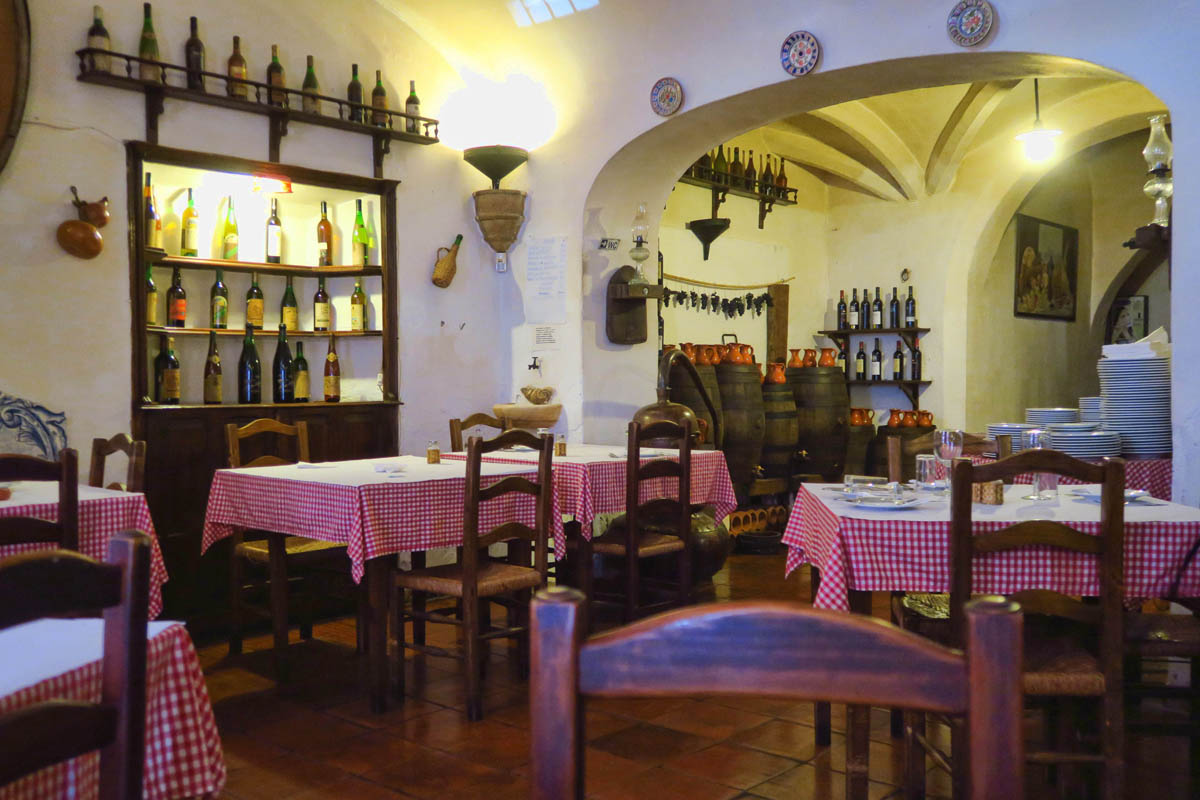
This local restaurant, Adega do Alentejano, is known for its typical Portuguese dish, Sopa de tomate Alentejana, or tomato soup with poached egg.
It is here in the Rota dos Vinhos do Alentejo that I learn about the different regions from which Portuguese wines originate, as well as the regulating bodies such as DOC (Denominação de Origem Controlada, or protected designation of origin) that govern them. He also tells me there have been discussions that the price of exported wine to the USA should be increased, because “Americans equate the quality of wine with the price.” It’s true, as I often equate any wine under $10 to “Two Buck Chuck.” However, it is possible to buy a beautiful bottle of really good wine in Portugal for under five Euro.
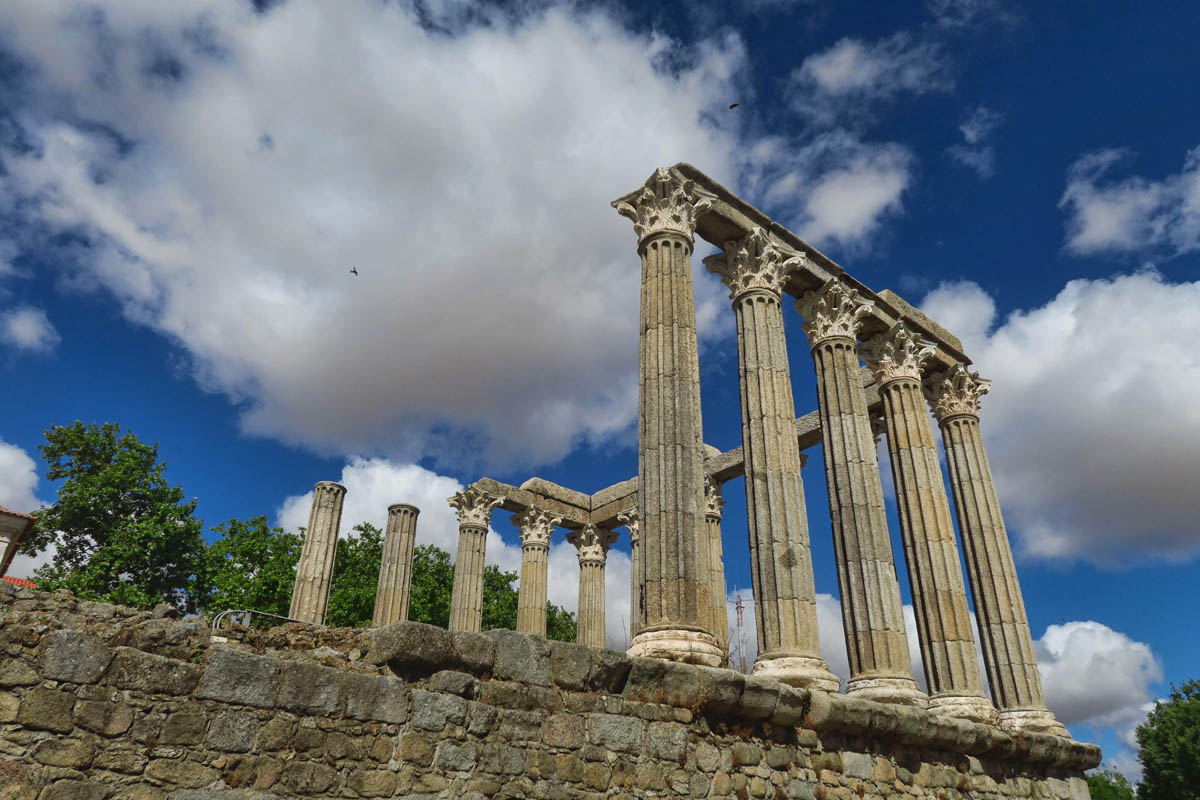
One of the most significant historical landmarks in Evora is he Roman Temple.

The temple, considered one of the best preserved Roman ruins on the Iberian peninsula, is located at the highest elevation of the city.
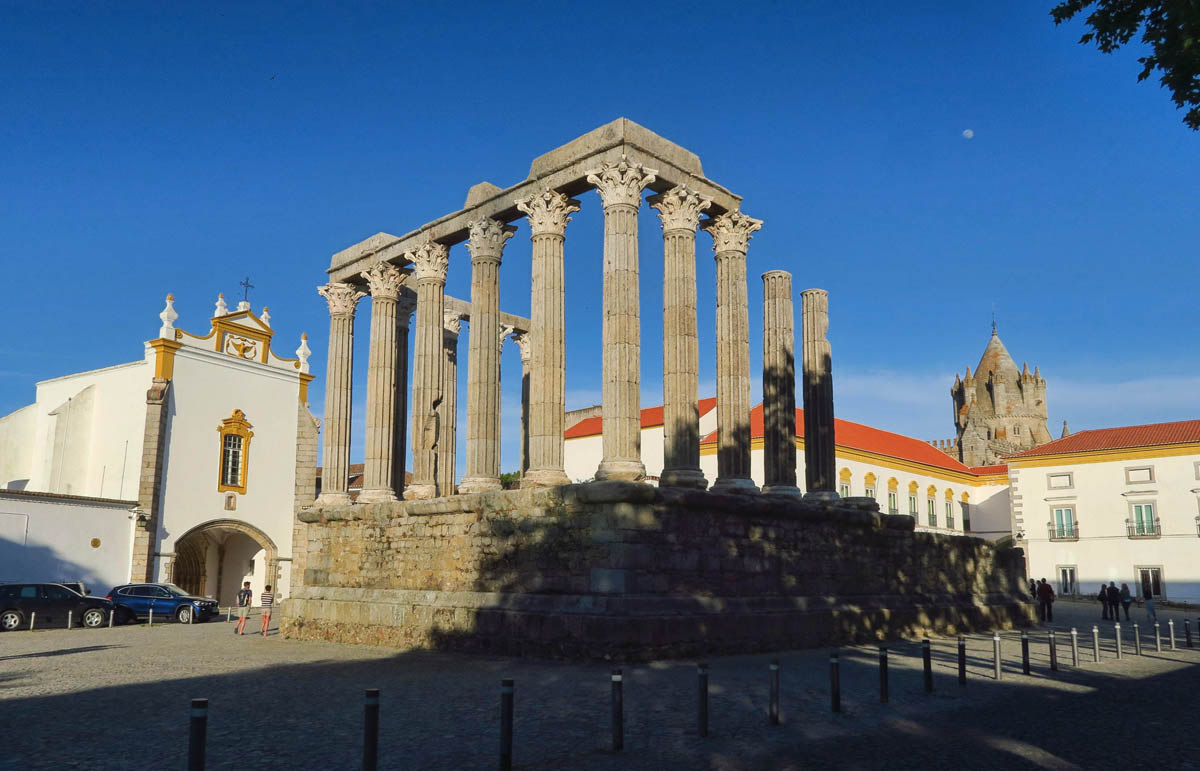
The temple, built in the first half of the 1st century AD, is dedicated to Diana, ancient Roman goddess of the moon. (Note near full moon rising in upper right corner.)
When selecting restaurants during my travels, I rely almost solely on Trip Advisor these days, as the site contains first hand reviews from travelers posted as recently as the same week. I typically find the reviews “spot on,” as fellow travelers are eager to share their impressions, photos, and suggested menu items. It’s pretty easy to tell which reviewers are “legit” as Trip Advisor posts their review history and contributor level achieved beneath the name of each reviewer. From this one app on my phone, I can filter restaurants by food type, location, price, and even which restaurants are “Open Now,” while clicking through to Google maps to get walking directions.
However, occasionally I go “old school” by reading the reviews in the Lonely Planet to see which restaurants have stood the test of time. Such was the case with “Botequim da Mouraria.” Not only has it achieved high marks all around in Trip Advisor, but Lonely Planet refers to it as “a culinary shrine for gastronomes.” A shrine? What better way to pique my curiosity! To further my interest, I am intrigued by a restaurant that has achieved such notoriety despite being closed on weekends, and consists solely of eight barstools at a small wooden bar for seating. Nothing does more for the popularity of a restaurant than exclusivity, it would seem. I had to check it out!
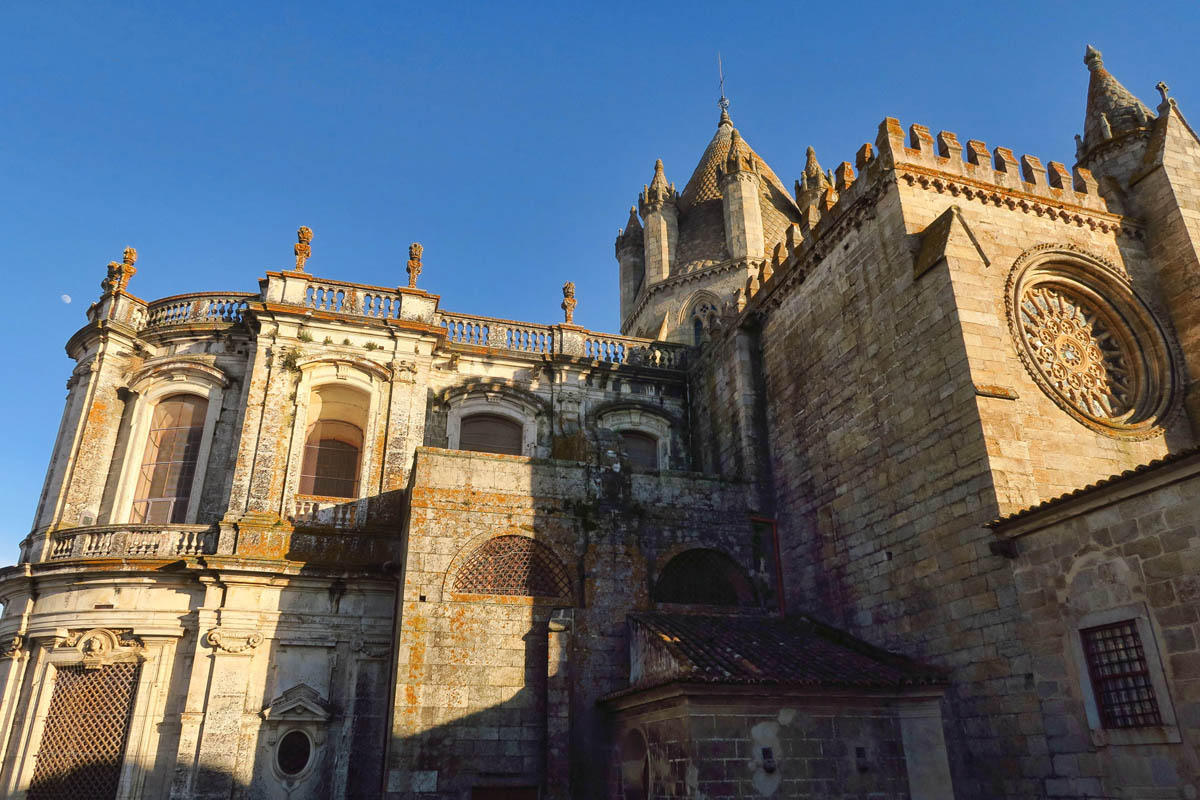
Evora also has one of the most beautiful Gothic Cathedrals in Portugal. made from rose granite. Construction spanned from 1184 to 1746.

It’s possible to climb up a series of staircases to reach the terrace which affords a phenomenal view.
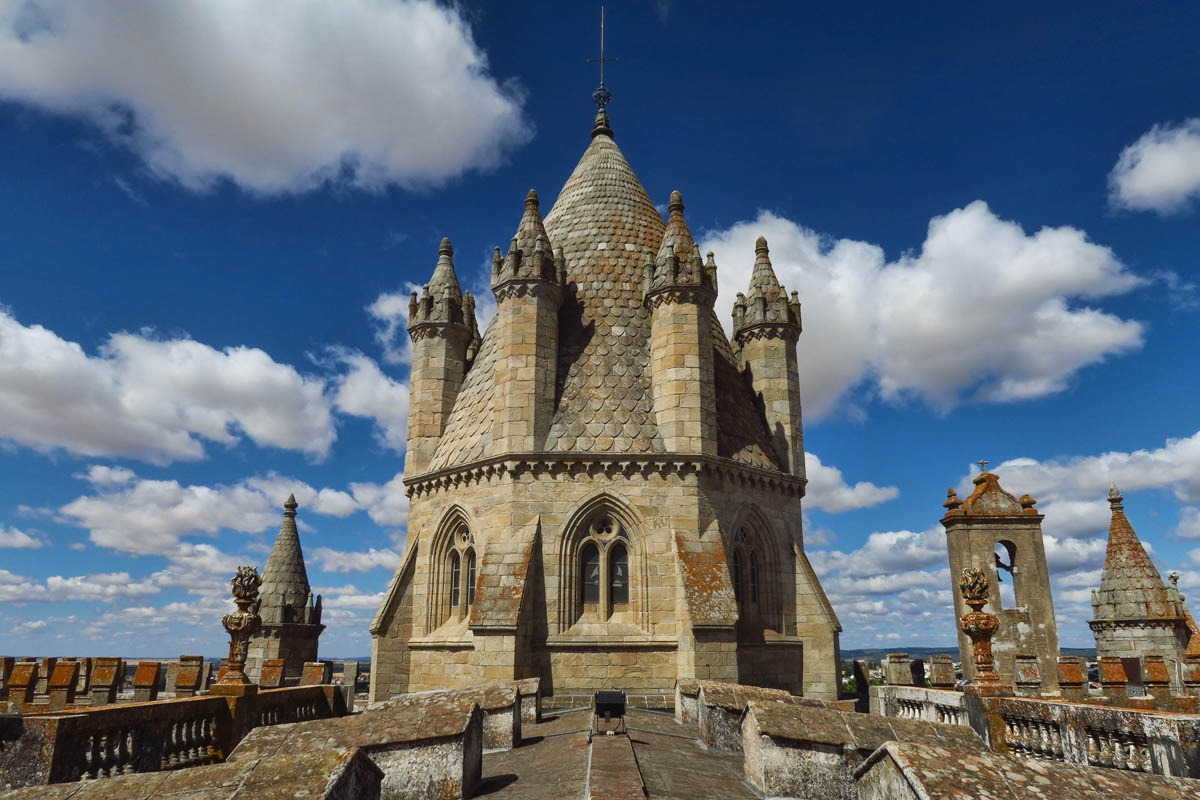
The lantern-tower with rock scales on the top.

The cloisters of the cathedral were built between 1317 and 1340.

Inside the cathedral, there is something quite rare and very unique about this statue of the Virgin Mary. Can you spot it?

This 15th century painted marble statue
shows a very pregnant Mary, which is extremely rare. The belief is that local priests thought they would have better success in converting local pagans if they displayed signs of fertility.
The first time I tried for a seat at Botequim da Mouraria, I arrived shortly after opening time to see a paper sign on the front door saying “COMPLETE.” All eight stools were filled, and there was no second seating. So much for my theory of “There’s always room for one more.”
For my second attempt, I decided to arrive half an hour before the restaurant opened. I was number eleven in line. No point even waiting, as customers one through eight weren’t going anywhere.
Would the third time be the charm? It was Friday night, and the restaurant was not open on weekends. I already had my train ticket to Lisbon on Sunday, so it was now or never. I would try an hour before opening this time, taking a book to read so as not to feel like a complete fool for standing there outside the door for an hour looking like a beggar. It was no longer about wanting to try the food. It had now turned into a personal challenge, like fighting over the last pair of snow shoes on the bargain table in Macy’s the night before the first snowstorm during my first winter in Manhattan.
But my arrival an hour in advance did the trick. I was first in line. In fact, I sat alone on the stoop for the first half hour before anyone else showed up. I could have been a little less fastidious, but I didn’t want to leave this small town behind without having paid homage to the “gastronome shrine!”

Finally, my wait pays off, as I am the first one of eight to be seated at the bar.
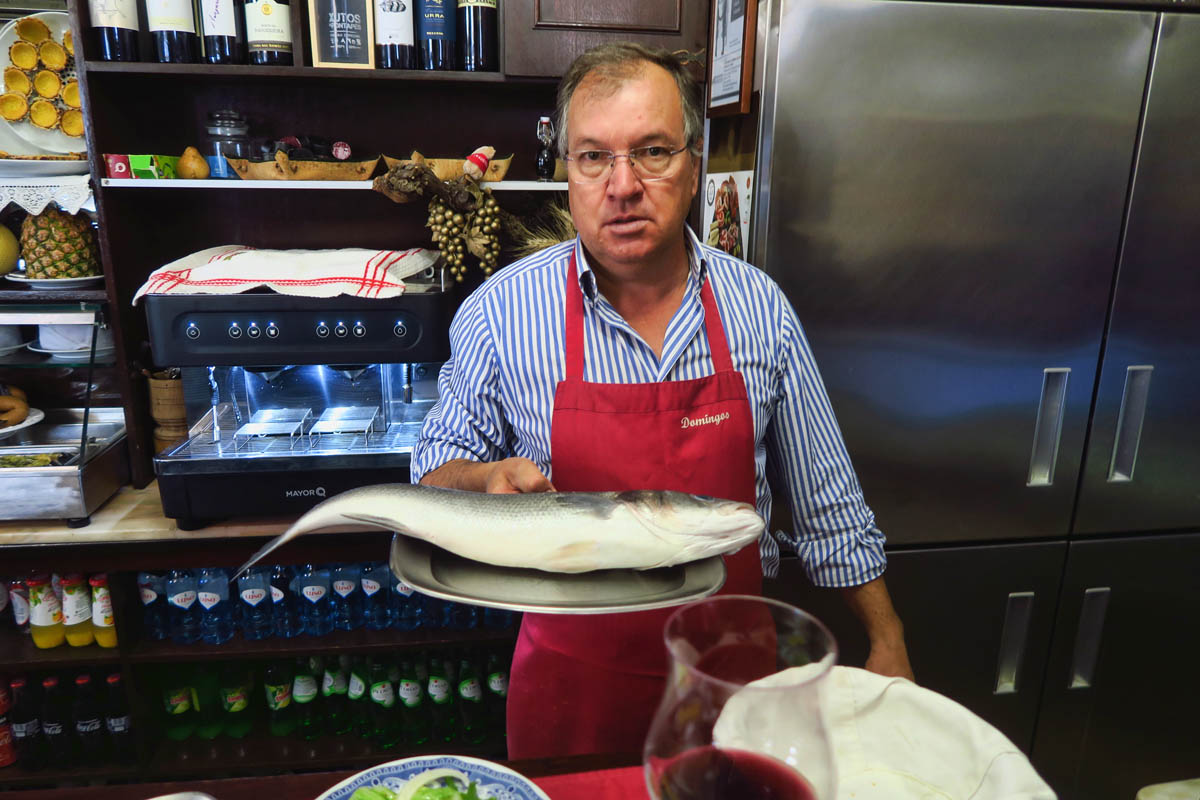
“Maybe our fish of the day?”

I choose an entree of “porco preto,” or “Black Pork” for which Portugal is famous. Named for their black skin, the pigs graze on acorns, which gives the meat a more rich flavor.
It wasn’t just the food. It was the ambiance of feeling like I was dining in Domingo, the owner’s home. His wife could be seen through the narrow doors into the tiny kitchen, preparing the entrees, while Domingo tended the bar, made recommendations, consulted each individual on taste preferences, and lovingly described each dish. He mixed salads and sliced bread, and plated each item right across the bar. Each refill of the wine glass required only eye contact, followed by a nod at the glass. Between the warmth from the wine and aromas from the kitchen, it was an intoxicating experience, like poetry in motion. It should be, after all, this husband and wife team has been serving behind this eight-seat bar for twenty-five years.
While there are plenty of reasons to visit Evora, from the architectural beauty to the robust, affordable wines, I expect my experience sitting at the bar in Botequim da Mouraria will hold the most lasting memory.

Hey! We’ll be close to you in a couple of weeks. We’re spending 2 weeks in Italy. We leave sept 28 with a layover in Madrid before arriving in Florence.
Reta, you are finally taking that trip to Italy! I am so excited for you!
Thanks! I’m excited, too! It’s number one on my bucket list, and has been for as long as I can remember!
One more place on our bucket list! Thank you for sharing!!
Beautiful photos, enjoyed everything about this post – thank you for sharing.
I enjoyed all your pictures and that Black pork sounded interesting, glad you git a seat at the bar.
The shape of the black pork . . . looked like a hog looking to the left. Am I imagining that?
As always, your word pictures and excellent photography press all my “travel buttons”. I actually DID look into getting to Portugal by boat, and a freighter seemed about right for my budget!
Virtual hugs,
Judie
The chapel sure sounds bizarre but interesting to see. The temple, dating back that far must have been incredible. Great job getting one of the 8 stools, is it mostly tourists eating there or do the local eat there as well?
Thanks, Jim and Barb, for the comment, and for always sticking with me. 😉 The old city of Evora was pretty touristy, so I don’t think many locals would eat there, but I do think many Portuguese tourists eat there. During my visit, I was only one of two people not from Spain or Portugal.
A funny story, while I was in line, a big black limo pulled up. A well heeled couple got out in fancy attire. They were told by the person at the end of the line that we were “eight,” and there would not be room for the two of them. Well, they said they had limo-ed all the way from Lisbon, and demanded to speak to the owner. Domingo came out and said “Sorry, we are complete.” They argued and pleaded their case, all the while I kept hoping he couldn’t cave. He didn’t, and they got back in their sleek black limo, which sped off down the cobblestone street. Somehow, that made my seat at the bar all that much more treasured. 😉
All that I can say to the black pork is wow! Great lead in and picture. Only last year did I do some reading on Portugal as my formal education was totally lacking on that country and sparse on Spain. Here in eastern MA there is a good sized population of people from Portuguese speaking countries and their food and wines have been fascinating to discover. I must find a NE restaurant to try that cut of pork. We are delighted that you are continuing to publish on your trip to this fascinating country. Thanks we love it.
Your travels to Potugal have been fun and informative
We are planning a trip to Portugal and I would like some personal information . Did you always stay at hostels and as a older couple we would prefer a
A private room. What kind of a budget did you have for the 2 months? How long did you stay in one place before moving on. We would travel as cheap as we could.
Will be in Az this winter?
We have a Escapees lot in Benson
Hope to meet you one day
Happy travels
Carolyn Kidd
Thanks for the questions, Carolyn, and for following along on the blog.
The only time I stayed in a hostel dorm was in Lisbon, and that was because I wanted to be centrally located near the main square and the water. There weren’t any guesthouses or affordable hotels in the heart of the city where I wanted to be, as I didn’t want to commute through the city late at night. So I stayed in a female dorm near the heart of town. But in all other cases in all other towns, I stayed in “guesthouses” with a private room.
I booked them all through the booking.com website. If you do a search, then sort by price from lowest to highest price, you will see a faint pink bar at the top with the notice, “Your results include some shared accommodations such as dormitory beds. Show private rooms only.” If you click on the link to show only private rooms, it will eliminate any dorm options, and you can then view the lowest price rooms, see photos, view on a map, and read other travelers reviews. I have a friend who used AirBnB, but I did not find that to be as affordable as booking.com, primarily because they charge both booking and cleaning fees.
My budget was $70 US per day to including food, tours, accommodations, and transportation. I think I came pretty close to that. I paid an average of $30 per night for the private rooms in guesthouses, but of course that was for a single room. It could be more for a double.
I had a pretty flexible schedule, often booking the next destination from the current one. I enjoyed the flexibility of staying longer in places I enjoyed. My minimum night stay was three nights, just because it was proving to be too exhausting to travel at a faster pace as I did 20 years ago. But in almost every town, I ended up extending my stay. It’s probably a little cheaper to confirm further out (I know bus and train tickets are cheaper with more advance booking) but I enjoyed the flexibility of staying longer when I was enjoying a particular place.
Let me know if you have any other questions!
Suzanne
This type of question and response is icing on the cake. Thank you for taking the time to explain the “how”. I always tuck these helpful gems away for future reference. Just in case…
Have you mentioned the dinner cost? Missed it somewhere . . . oh jeeze Suzanne, you are making me so wishful that I was back in Europe, all the sights and even the nods for service when waiters/waitresses know exactly what/when you want something, the ambience of dining, the skulls/bones collection, the pregnant Mary! it’s all very European! My heart belongs in Europe!
Hi, Terri. Thanks for the question on dinner costs. I decided to incorporate my answer into the next post. Appreciate you following along!
What’s that side dish – potato chips? Love the pregnant Mary – that’s a new one for me. There’s a “bone church” in Prague I hope to make it to in a couple of years.
Yes, believe it or not, potato chips served with dinner are as common as mashed potatoes in the south!
I so enjoyed your story about Botequim da Mouraria, particularly the moment of eye contact, then nod at your glass. The silent request met with obliged accommodation. The subtlety with which the wish was granted. The magic of the moment…one of those infrequent treasured moments of life that sear into the memory bank. What a delightful evening that must have been for you. It sounds positively exquisite…